T2 2019 HC1010 Accounting for Business Decisions Assignment
VerifiedAdded on 2022/11/15
|7
|1290
|350
Homework Assignment
AI Summary
This assignment solution addresses key aspects of accounting for business decisions. It begins by exploring different organizational forms (sole proprietorship, partnership, and corporation) and their implications for business operations and finance, discussing the advantages and disadvantages of each. The solution then analyzes the impact of organizational structure on finance availability, highlighting how corporations can raise the most capital. It further delves into debt and equity financing methods, outlining the characteristics, advantages, and disadvantages of each. The assignment also examines how accounting information from financial reports aids in business decision-making, including the importance of reviewing assets, liabilities, and non-financial information such as social, environmental, and human rights disclosures. Finally, the solution underscores the essential accounting skills and knowledge required for managing a business effectively, emphasizing technical skills, communication, and predictive abilities.
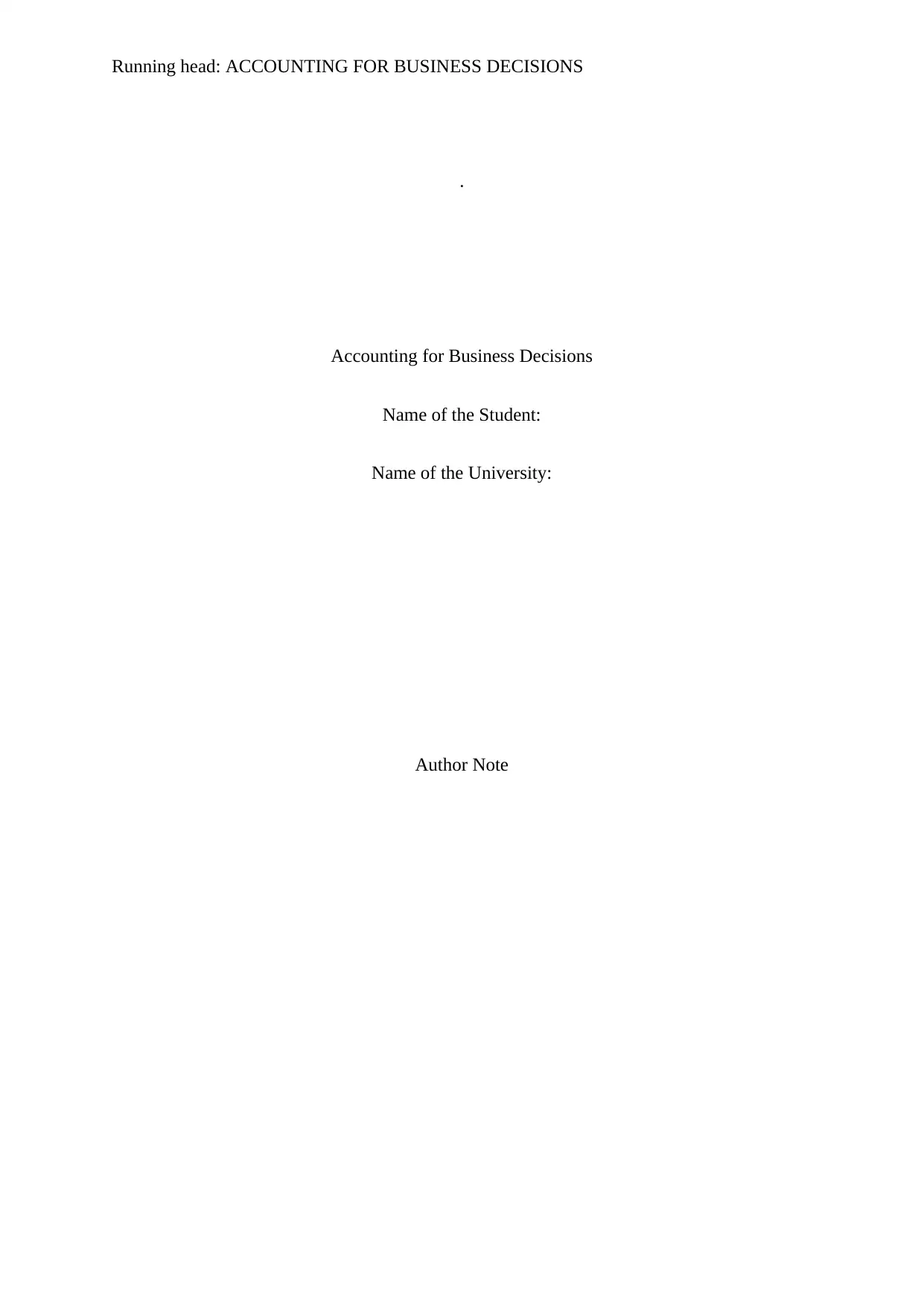
Running head: ACCOUNTING FOR BUSINESS DECISIONS
.
Accounting for Business Decisions
Name of the Student:
Name of the University:
Author Note
.
Accounting for Business Decisions
Name of the Student:
Name of the University:
Author Note
Paraphrase This Document
Need a fresh take? Get an instant paraphrase of this document with our AI Paraphraser
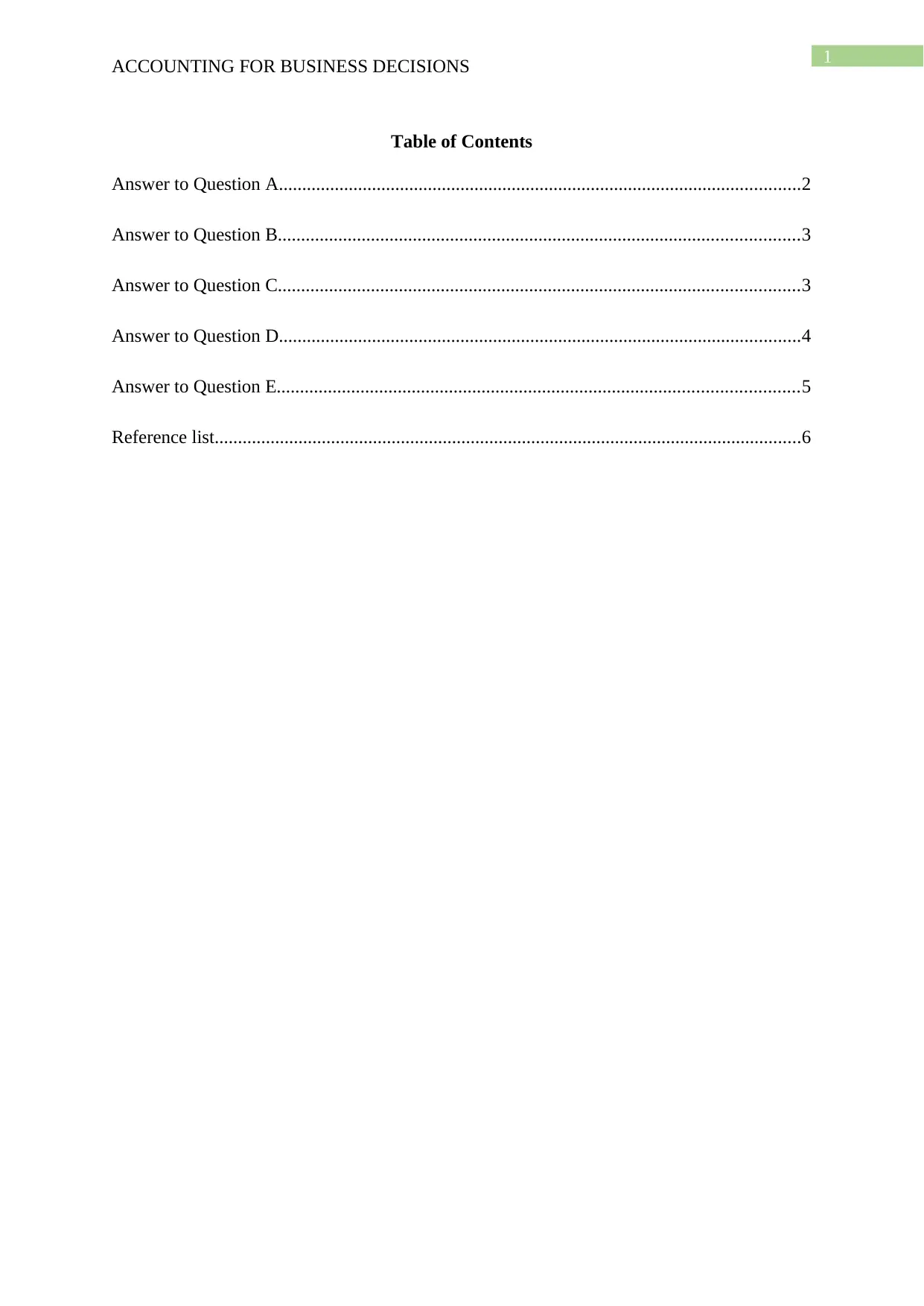
1
ACCOUNTING FOR BUSINESS DECISIONS
Table of Contents
Answer to Question A................................................................................................................2
Answer to Question B................................................................................................................3
Answer to Question C................................................................................................................3
Answer to Question D................................................................................................................4
Answer to Question E................................................................................................................5
Reference list..............................................................................................................................6
ACCOUNTING FOR BUSINESS DECISIONS
Table of Contents
Answer to Question A................................................................................................................2
Answer to Question B................................................................................................................3
Answer to Question C................................................................................................................3
Answer to Question D................................................................................................................4
Answer to Question E................................................................................................................5
Reference list..............................................................................................................................6
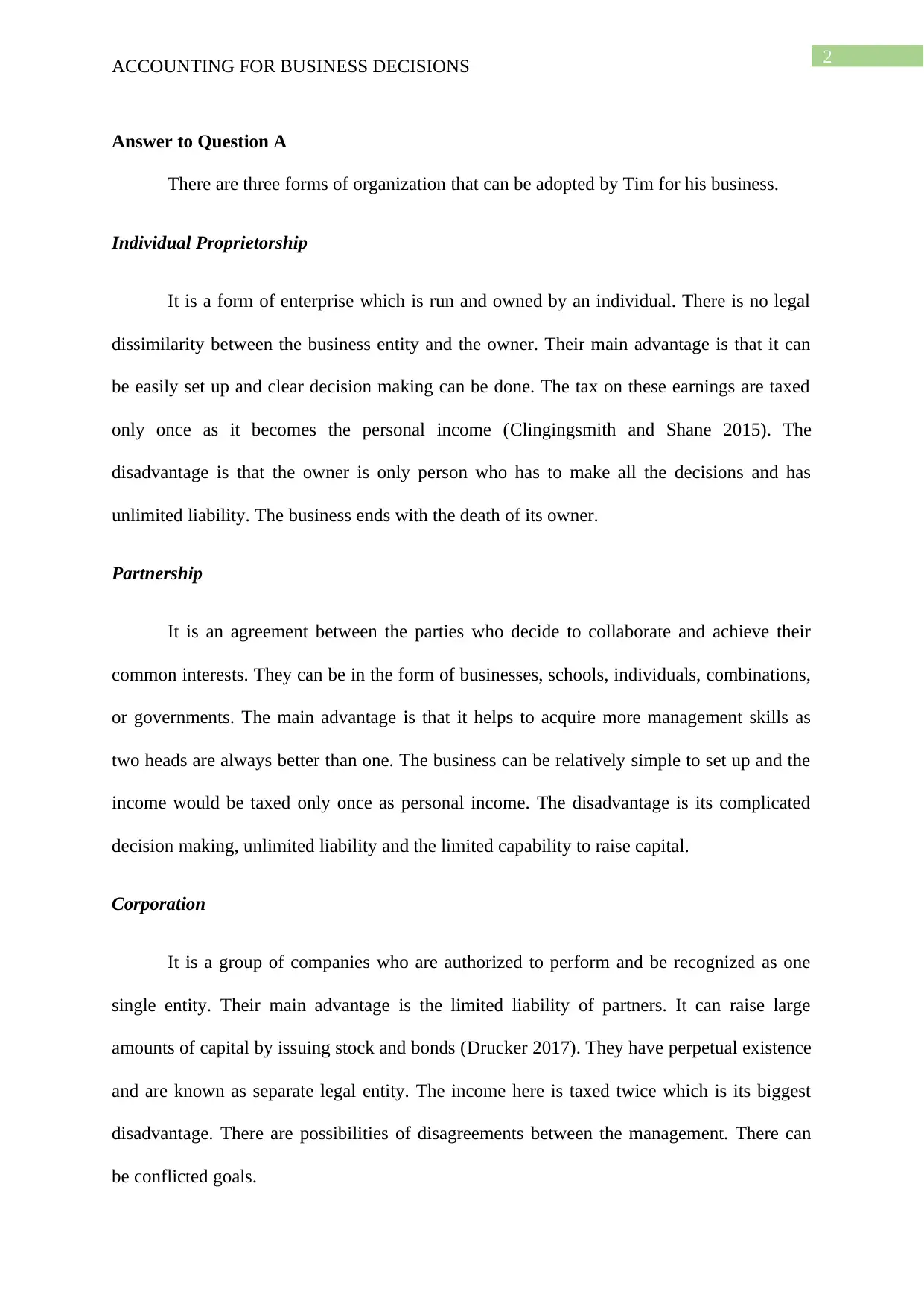
2
ACCOUNTING FOR BUSINESS DECISIONS
Answer to Question A
There are three forms of organization that can be adopted by Tim for his business.
Individual Proprietorship
It is a form of enterprise which is run and owned by an individual. There is no legal
dissimilarity between the business entity and the owner. Their main advantage is that it can
be easily set up and clear decision making can be done. The tax on these earnings are taxed
only once as it becomes the personal income (Clingingsmith and Shane 2015). The
disadvantage is that the owner is only person who has to make all the decisions and has
unlimited liability. The business ends with the death of its owner.
Partnership
It is an agreement between the parties who decide to collaborate and achieve their
common interests. They can be in the form of businesses, schools, individuals, combinations,
or governments. The main advantage is that it helps to acquire more management skills as
two heads are always better than one. The business can be relatively simple to set up and the
income would be taxed only once as personal income. The disadvantage is its complicated
decision making, unlimited liability and the limited capability to raise capital.
Corporation
It is a group of companies who are authorized to perform and be recognized as one
single entity. Their main advantage is the limited liability of partners. It can raise large
amounts of capital by issuing stock and bonds (Drucker 2017). They have perpetual existence
and are known as separate legal entity. The income here is taxed twice which is its biggest
disadvantage. There are possibilities of disagreements between the management. There can
be conflicted goals.
ACCOUNTING FOR BUSINESS DECISIONS
Answer to Question A
There are three forms of organization that can be adopted by Tim for his business.
Individual Proprietorship
It is a form of enterprise which is run and owned by an individual. There is no legal
dissimilarity between the business entity and the owner. Their main advantage is that it can
be easily set up and clear decision making can be done. The tax on these earnings are taxed
only once as it becomes the personal income (Clingingsmith and Shane 2015). The
disadvantage is that the owner is only person who has to make all the decisions and has
unlimited liability. The business ends with the death of its owner.
Partnership
It is an agreement between the parties who decide to collaborate and achieve their
common interests. They can be in the form of businesses, schools, individuals, combinations,
or governments. The main advantage is that it helps to acquire more management skills as
two heads are always better than one. The business can be relatively simple to set up and the
income would be taxed only once as personal income. The disadvantage is its complicated
decision making, unlimited liability and the limited capability to raise capital.
Corporation
It is a group of companies who are authorized to perform and be recognized as one
single entity. Their main advantage is the limited liability of partners. It can raise large
amounts of capital by issuing stock and bonds (Drucker 2017). They have perpetual existence
and are known as separate legal entity. The income here is taxed twice which is its biggest
disadvantage. There are possibilities of disagreements between the management. There can
be conflicted goals.
⊘ This is a preview!⊘
Do you want full access?
Subscribe today to unlock all pages.

Trusted by 1+ million students worldwide

3
ACCOUNTING FOR BUSINESS DECISIONS
Answer to Question B
Yes, the choice of organization will have an effect on the availability of finance for
his business. If he choose the individual proprietorship form of business then he would be the
only person who would be contributing capital to the business. On the other hand, in a
partnership the capital contributed by the partners would be relatively more as compared to
the sole proprietorship. Since there would be involvement of more than one individual. The
Corporation has the largest amount of capital that can be pooled. As it has more number of
partners contributing to the business and the company can further raise more finance from the
share and bonds issued in the market.
Answer to Question C
The required finance can be raised by two methods-
Debt Financing
The debt capital arises when the company borrows the fund with an agreement to
repay it to the lender on a fixed date in the future. Bonds and loans are the common types of
debt capital that are used by large companies to fund their new projects or for expansion of
existing project. The company may have to approach the bank for obtaining the loan and will
have to provide with collateral for obtaining the loan (Haw, Lee and Lee 2014). The
collaterals can be in the form of documents which will serve as a proof of the ability of the
company to repay the loan. The bonds issued in the market are sold to the investors and
mature post a certain date in the future.
Equity Financing
The equity capital is not financed by borrowing money instead it is generated by
selling the preferred or common shares of the company stock. It dilutes the ownership of the
ACCOUNTING FOR BUSINESS DECISIONS
Answer to Question B
Yes, the choice of organization will have an effect on the availability of finance for
his business. If he choose the individual proprietorship form of business then he would be the
only person who would be contributing capital to the business. On the other hand, in a
partnership the capital contributed by the partners would be relatively more as compared to
the sole proprietorship. Since there would be involvement of more than one individual. The
Corporation has the largest amount of capital that can be pooled. As it has more number of
partners contributing to the business and the company can further raise more finance from the
share and bonds issued in the market.
Answer to Question C
The required finance can be raised by two methods-
Debt Financing
The debt capital arises when the company borrows the fund with an agreement to
repay it to the lender on a fixed date in the future. Bonds and loans are the common types of
debt capital that are used by large companies to fund their new projects or for expansion of
existing project. The company may have to approach the bank for obtaining the loan and will
have to provide with collateral for obtaining the loan (Haw, Lee and Lee 2014). The
collaterals can be in the form of documents which will serve as a proof of the ability of the
company to repay the loan. The bonds issued in the market are sold to the investors and
mature post a certain date in the future.
Equity Financing
The equity capital is not financed by borrowing money instead it is generated by
selling the preferred or common shares of the company stock. It dilutes the ownership of the
Paraphrase This Document
Need a fresh take? Get an instant paraphrase of this document with our AI Paraphraser
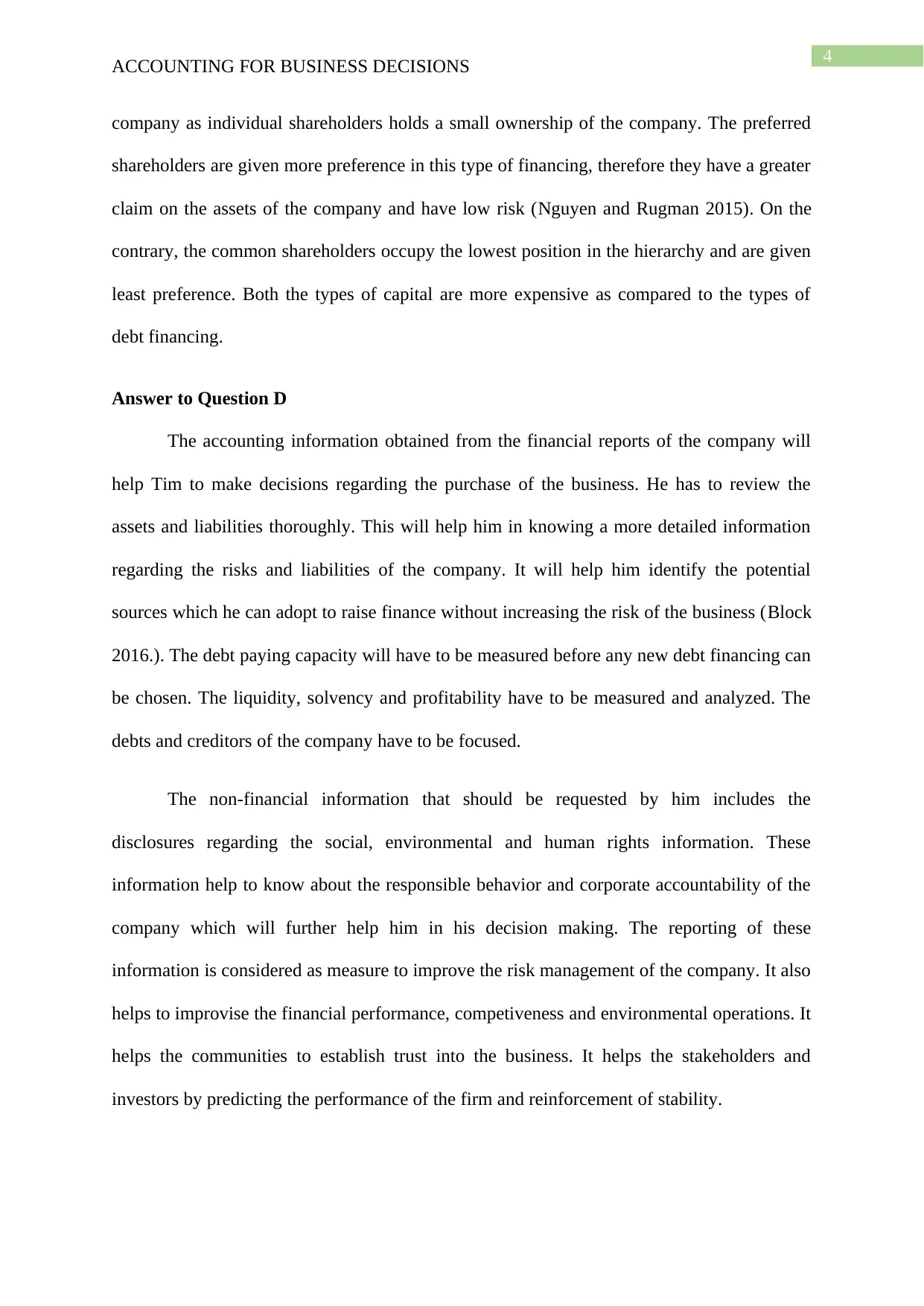
4
ACCOUNTING FOR BUSINESS DECISIONS
company as individual shareholders holds a small ownership of the company. The preferred
shareholders are given more preference in this type of financing, therefore they have a greater
claim on the assets of the company and have low risk (Nguyen and Rugman 2015). On the
contrary, the common shareholders occupy the lowest position in the hierarchy and are given
least preference. Both the types of capital are more expensive as compared to the types of
debt financing.
Answer to Question D
The accounting information obtained from the financial reports of the company will
help Tim to make decisions regarding the purchase of the business. He has to review the
assets and liabilities thoroughly. This will help him in knowing a more detailed information
regarding the risks and liabilities of the company. It will help him identify the potential
sources which he can adopt to raise finance without increasing the risk of the business (Block
2016.). The debt paying capacity will have to be measured before any new debt financing can
be chosen. The liquidity, solvency and profitability have to be measured and analyzed. The
debts and creditors of the company have to be focused.
The non-financial information that should be requested by him includes the
disclosures regarding the social, environmental and human rights information. These
information help to know about the responsible behavior and corporate accountability of the
company which will further help him in his decision making. The reporting of these
information is considered as measure to improve the risk management of the company. It also
helps to improvise the financial performance, competiveness and environmental operations. It
helps the communities to establish trust into the business. It helps the stakeholders and
investors by predicting the performance of the firm and reinforcement of stability.
ACCOUNTING FOR BUSINESS DECISIONS
company as individual shareholders holds a small ownership of the company. The preferred
shareholders are given more preference in this type of financing, therefore they have a greater
claim on the assets of the company and have low risk (Nguyen and Rugman 2015). On the
contrary, the common shareholders occupy the lowest position in the hierarchy and are given
least preference. Both the types of capital are more expensive as compared to the types of
debt financing.
Answer to Question D
The accounting information obtained from the financial reports of the company will
help Tim to make decisions regarding the purchase of the business. He has to review the
assets and liabilities thoroughly. This will help him in knowing a more detailed information
regarding the risks and liabilities of the company. It will help him identify the potential
sources which he can adopt to raise finance without increasing the risk of the business (Block
2016.). The debt paying capacity will have to be measured before any new debt financing can
be chosen. The liquidity, solvency and profitability have to be measured and analyzed. The
debts and creditors of the company have to be focused.
The non-financial information that should be requested by him includes the
disclosures regarding the social, environmental and human rights information. These
information help to know about the responsible behavior and corporate accountability of the
company which will further help him in his decision making. The reporting of these
information is considered as measure to improve the risk management of the company. It also
helps to improvise the financial performance, competiveness and environmental operations. It
helps the communities to establish trust into the business. It helps the stakeholders and
investors by predicting the performance of the firm and reinforcement of stability.

5
ACCOUNTING FOR BUSINESS DECISIONS
Answer to Question E
The skills and accounting knowledge of an individual are essential for him to manage
the business. The accounting transactions may be complex but he has to pay attention to
every detail. He must possess certain technical accounting skills for the success of the
business. He should be able to communicate and evaluate the financial information in a
comprehensible manner. He should have predictive skills so that he can forecast the impact of
the factors on its business operations. He must be proactive in his approaches. He should
possess some flexibility so that he can help others by fitting into multiple roles. With the
technological advancements, he has to be updated with the technical skills as it will affect the
quality of information that he would present. He must possess good communication skills so
that he can communicate and understand his employees and they can feel him as an
approachable person.
ACCOUNTING FOR BUSINESS DECISIONS
Answer to Question E
The skills and accounting knowledge of an individual are essential for him to manage
the business. The accounting transactions may be complex but he has to pay attention to
every detail. He must possess certain technical accounting skills for the success of the
business. He should be able to communicate and evaluate the financial information in a
comprehensible manner. He should have predictive skills so that he can forecast the impact of
the factors on its business operations. He must be proactive in his approaches. He should
possess some flexibility so that he can help others by fitting into multiple roles. With the
technological advancements, he has to be updated with the technical skills as it will affect the
quality of information that he would present. He must possess good communication skills so
that he can communicate and understand his employees and they can feel him as an
approachable person.
⊘ This is a preview!⊘
Do you want full access?
Subscribe today to unlock all pages.

Trusted by 1+ million students worldwide
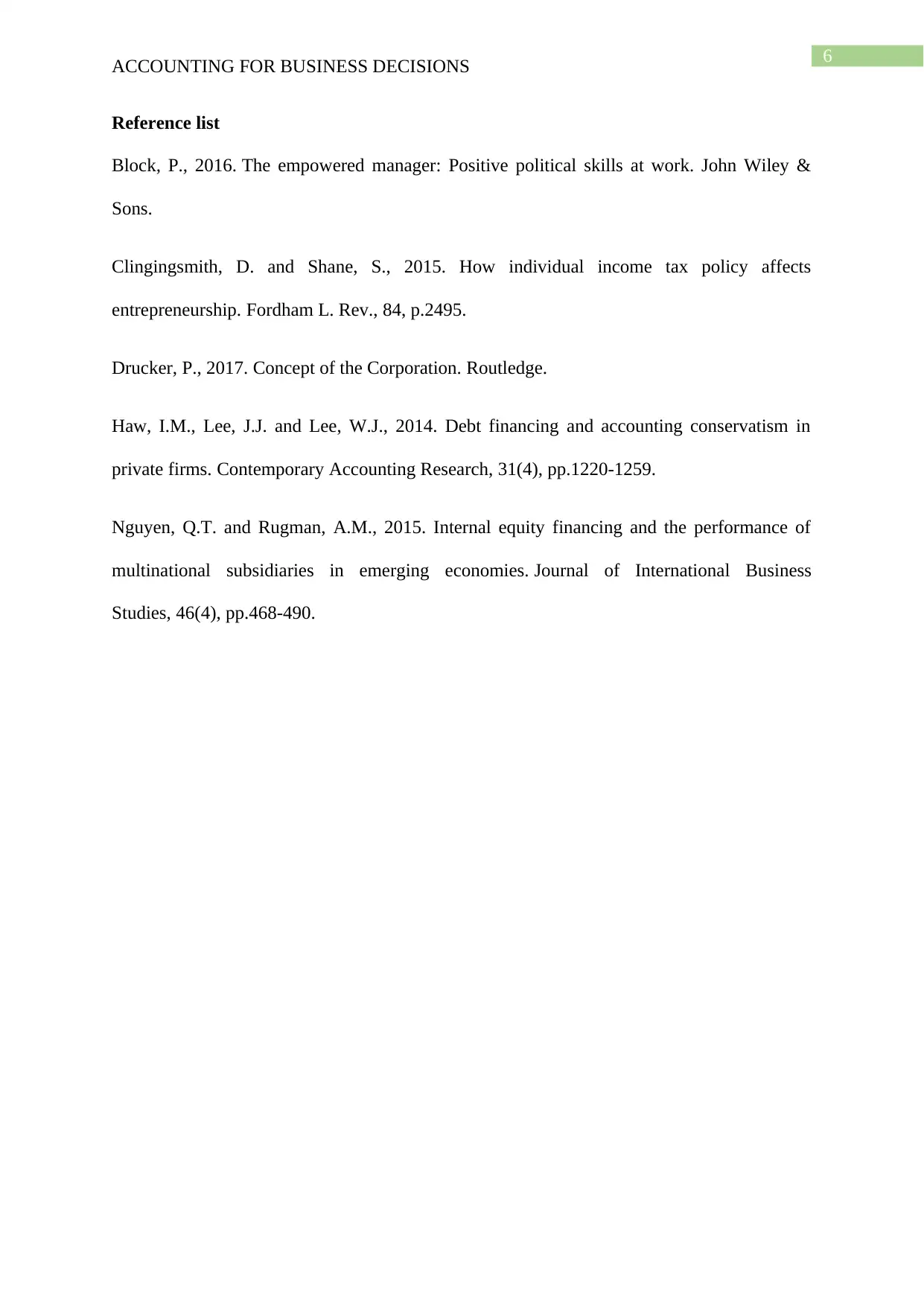
6
ACCOUNTING FOR BUSINESS DECISIONS
Reference list
Block, P., 2016. The empowered manager: Positive political skills at work. John Wiley &
Sons.
Clingingsmith, D. and Shane, S., 2015. How individual income tax policy affects
entrepreneurship. Fordham L. Rev., 84, p.2495.
Drucker, P., 2017. Concept of the Corporation. Routledge.
Haw, I.M., Lee, J.J. and Lee, W.J., 2014. Debt financing and accounting conservatism in
private firms. Contemporary Accounting Research, 31(4), pp.1220-1259.
Nguyen, Q.T. and Rugman, A.M., 2015. Internal equity financing and the performance of
multinational subsidiaries in emerging economies. Journal of International Business
Studies, 46(4), pp.468-490.
ACCOUNTING FOR BUSINESS DECISIONS
Reference list
Block, P., 2016. The empowered manager: Positive political skills at work. John Wiley &
Sons.
Clingingsmith, D. and Shane, S., 2015. How individual income tax policy affects
entrepreneurship. Fordham L. Rev., 84, p.2495.
Drucker, P., 2017. Concept of the Corporation. Routledge.
Haw, I.M., Lee, J.J. and Lee, W.J., 2014. Debt financing and accounting conservatism in
private firms. Contemporary Accounting Research, 31(4), pp.1220-1259.
Nguyen, Q.T. and Rugman, A.M., 2015. Internal equity financing and the performance of
multinational subsidiaries in emerging economies. Journal of International Business
Studies, 46(4), pp.468-490.
1 out of 7
Related Documents
Your All-in-One AI-Powered Toolkit for Academic Success.
+13062052269
info@desklib.com
Available 24*7 on WhatsApp / Email
![[object Object]](/_next/static/media/star-bottom.7253800d.svg)
Unlock your academic potential
Copyright © 2020–2025 A2Z Services. All Rights Reserved. Developed and managed by ZUCOL.




